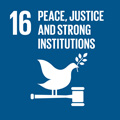- Docente: Francesca Cremonini
- Credits: 8
- SSD: SPS/07
- Language: Italian
- Teaching Mode: In-person learning (entirely or partially)
- Campus: Forli
- Corso: Second cycle degree programme (LM) in Criminology for Investigation and Security (cod. 8491)
-
from Feb 26, 2025 to May 21, 2025
Learning outcomes
The course examines the main sociological and criminological research methods and the related investigation techniques. At the end of the course the student will have acquired the necessary skills in order to: a) prepare a research project on specific social issues; b) use the various techniques both in the construction and in the administration phase (identifying the most suitable one in relation to the phenomenon to be investigated and the established cognitive objectives); c) interpret the results of an investigation and critically analyze, from a methodological point of view, research reports referring to empirical sociological and criminological research.
Course contents
The course's introductory part focuses on the main research traditions and the debate on the method, on the fundamental elements of the methodological discourse, and the processes common to empirical research, with particular attention to standard research: properties, indicators, indices, variables. The course then illustrates the research models used in the main theoretical approaches to the study of crime to highlight the link between theory and empirical research: theories of physical typology and genetic theories, psychodynamic, criminological, and victimological theories.
The main research techniques in social sciences will be illustrated (survey with a questionnaire, second-level analysis on statistical sources, life histories, and participant observation) with particular attention to the specific problems that their use for investigations in the criminological and victimological ambit. The aim is to provide students with the necessary knowledge to choose the investigation path most appropriate from time to time to the areas and phenomena of study they will concretely face in a possible professional future.
Readings/Bibliography
Meraviglia C. (2004), Metodologia delle scienze sociali. Un’introduzione, Carocci, Roma.
Cremonini F. (2021), Tecniche di ricerca criminologica, FrancoAngeli, Milano (in corso di stampa).
For the monographic part, a text chosen from:
- ISTAT (2009), La violenza contro le donne: indagine multiscopo sulle famiglie ‘Sicurezza delle donne’ anno 2006, a cura di M.G. Muratore, R. Barletta e A. Federici, ISTAT, Roma.
- Dino A. (2016), A colloquio con Gaspare Spatuzza. Un racconto di vita, una storia di stragi, il Mulino, Bologna.
- Omizzolo M. (2019), Sotto padrone. Uomini, donne e caporali nell’agromafia italiana, Feltrinelli, Milano.
- Santangelo F. (2017), La violenza nelle relazioni intime. La trasmissione intergenerazionale degli abusi contro le donne, FrancoAngeli, Milano.
Teaching methods
Lectures.
Within the course website's download area, PowerPoint presentations will be available a week before each lesson (you can identify the file by topic and date).
Please note that slides do not replace suggested books; they are mean for studying support.
Teamwork.
Attending students, divided into groups, will prepare and present in the classroom a PowerPoint on one of the books of their choice.
Assessment methods
The examination is the same for students attending and not attending; only the evaluation process is different.
Attending students can take an intermediate written test online, with mainly multiple-choice questions on the text of Meraviglia, group work on the monograph of their choice, and an oral exam on the text of Cremonini.
Non-attending students will take an oral exam on the entire program.
The written test and the group work will contribute 50% of the overall evaluation. In the written test, the score, expressed out of thirty, will correspond to the sum of the correct answer points, up to a maximum of 25 points. At least 15 points must be obtained to pass the test. Group work assigns up to a maximum of 5 points; at least 3 points must be obtained to pass this test.
As for the final oral exam, assessment criteria relate to three areas:
1. the ability to define the subject and to develop it in its essential components;
2. accuracy in the discussion of the individual members of the topic;
3. mastery of expository style.
The exact execution of the first point is required to pass the examination.
The arithmetic average between the sum of the marks obtained in the written test and the group work and the mark, expressed out of thirty, of the oral exam, constitutes the final mark.
Teaching tools
PowerPoint
Office hours
See the website of Francesca Cremonini
SDGs

This teaching activity contributes to the achievement of the Sustainable Development Goals of the UN 2030 Agenda.
